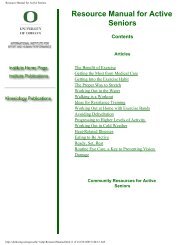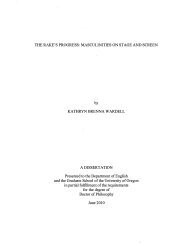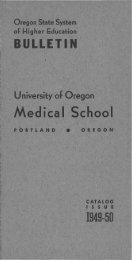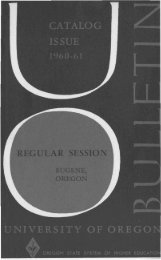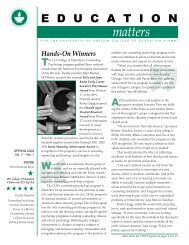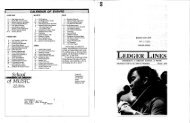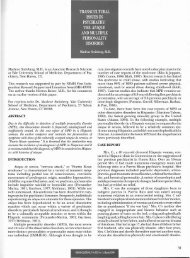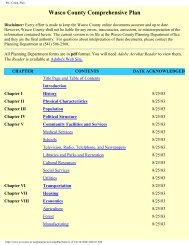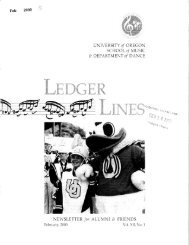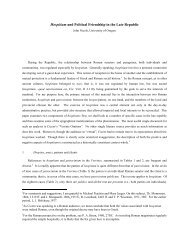~EGULAR SESSION - University of Oregon
~EGULAR SESSION - University of Oregon
~EGULAR SESSION - University of Oregon
Create successful ePaper yourself
Turn your PDF publications into a flip-book with our unique Google optimized e-Paper software.
PHYSICS<br />
Physics<br />
Pr<strong>of</strong>essors: J. L. POWELL (department head), BERND CRASEMANN, S. Y. CH'EN,<br />
E. G. EBBIGHAUSEN, R. T. ELLICKSON, G. H. WANNIER.<br />
Associate Pr<strong>of</strong>essors: F. E. DART, H. J. HROSTOWSKI, J. W. MCCLURE.<br />
Assistant Pr<strong>of</strong>essors: M. D. GIRARDEAU, J. C. KEMP, H. W. LEFEVRE, D. K. Mc-<br />
DANIELS, D. O. WELLs.<br />
Associate: U. N. UPADHYAYA.<br />
Fellows: S. D. CLOUD, K. W. DOLAN, R. P. HEBERT, C. J. PILUSO, C. A. SMITH.<br />
Assistants: J. L. BINNEY, H. H. CHAU, H. M. COLBERT, M. E. CUNNINGHAM,<br />
P. A. DEUTCHMANN, R. O. GARRETT, D. E. GILBERT, Q. A. HOLMES, J. T.<br />
HUNT, JR., B. L. JONES, J. W. LEONARD, A. T. LoNSETH, E. C. Lom, G. A.<br />
Moss, V. 1. NEELEY, M.A. PHILIPPAS, P. V. RAO, JOHN RUVALDS, PAUL<br />
STEPHAS, D. H. TANIMOTO, A. A. TEMPERLEY, JUDITH K. TEMPERLEY, J. P.<br />
VAN DYKE, W. M. ZINIKER.<br />
COURSES OFFERED by the Department <strong>of</strong> Physics are planned to provide<br />
basic training for (1) pr<strong>of</strong>essional physics majors, (2) persons desiring a broad<br />
liberal arts education centered around a major in physics, (3) major students in<br />
other science fields, (4) premedical and predental students, and (5) students planning<br />
to teach the physical sciences in the secondary schools.<br />
The major requirements for a bachelor's degree are: General Physics (Ph<br />
201, 202, 203) ; General Physics Laboratory (Ph 204, 205, 206) ; Introductory<br />
College Mathematics (Mth 104, 105, 106); Differential and Integral Calculus<br />
(Mth 201, 202, 203) ; General Chemistry (Ch 104, 105, 106, Ch 108, Ch 109) ;<br />
Advanced General Physics (Ph 320, 321, 322) ; Modern Physics (Ph 411, 412,<br />
413) ; Electricity and Magnetism (Ph 431,432,433) ; and two additional sequences<br />
chosen from the following: Advanced Optics (Ph441, 442, 443), Thermodynamics<br />
and Kinetic Theory (Ph 451, 452, 453), Introduction to Theoretical Physics<br />
(Ph 471, 472, 473), Differential Equations (Mth 418), Functions <strong>of</strong> Several<br />
Variables (Mth 419), Vector Analysis (Mth 420), Physical Chemistry (Ch 441,<br />
442,443) .<br />
Students planning to teach in the secondary schools must take required courses<br />
in education (see SCHOOL OF EDUCATION) .<br />
Subject Preparation for High-School Teaching. For certification as a<br />
teacher <strong>of</strong> physics in <strong>Oregon</strong> high schools, the student's program must include<br />
the subject-preparation requirements <strong>of</strong> the <strong>Oregon</strong> State Department <strong>of</strong> Education.<br />
These requirements are: for a basic certificate, granted after four years<br />
<strong>of</strong> college work, a basic norm-36 term hours, including work in general physics,<br />
intermediate physics, and modern physics; for a standard certificate, granted after<br />
five years <strong>of</strong> college work, a standard norm-54 term hours, including the basicnorm<br />
requirement. (A teacher who has completed the standard-norm requirement<br />
in physics and 12 term hours in chemistry may qualify for the teaching <strong>of</strong><br />
chemistry as a second field.)<br />
These requirements will be mandatory after July 1, 1965. The minimum<br />
subject requirements for students who qualify for certification before this date are<br />
published in the 1962-63 <strong>University</strong> Catalog, page 265.<br />
Honors. See HONORS COLLEGE, pages 120-123.<br />
Graduate Work. The Department <strong>of</strong> Physics <strong>of</strong>fers a program <strong>of</strong> graduate<br />
work leading to the M.A., M.S., and Ph.D. degrees, with a variety <strong>of</strong> opportunities<br />
for research. Some fields <strong>of</strong> current research interest in the department are the<br />
following: Nuclear physics-nuclear structure, including beta- and gamma-ray<br />
spectroscopy; nuclear theory. Solid state physics-optical and magnetic resonance<br />
195



